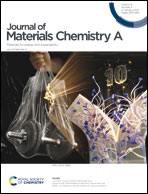Photo-enhanced piezocatalytic hydrogen evolution using in situ silver piezodeposited scheelite-type BaMoO4 and BaWO4†
Abstract
Piezocatalysis shows promise to diversify hydrogen production methods and solve problems in photocatalysis such as high charge recombination and low solar light absorption by waste mechanical energy. Scheelite type BaWO4 and BaMoO4 have been used in piezocatalytic hydrogen production due to their non-centrosymmetric crystal structure and piezoelectric and electrochemical properties for the first time. Piezocatalytic hydrogen production of BaMoO4 and BaWO4 was observed to be 198 and 313 μmol g−1 h−1, respectively, under ultrasonic sound. In order to increase the piezocatalytic hydrogen production activities, in situ Ag piezodeposition was performed on BaMoO4 and BaWO4 catalyst surfaces, and the hydrogen production was found to be 365 and 469 μmol g−1 h−1, respectively. Schottky junctions between BaWO4 and Ag (or BaMoO4 and Ag) enhanced the separation and migration of piezoelectric polarization charges formed on the non-centrosymmetric unit cells. Moreover, photopiezocatalytic hydrogen production of BaMoO4 and BaWO4 was investigated by application of both visible light irradiation and ultrasonic sound, and then it reached 789 and 1103 μmol g−1 h−1, respectively. The bending of valence and conduction bands of BaWO4 and BaMoO4 occurs under mechanical stress, can lead to a reduced band gap energy. BaWO4 and BaMoO4 generate photoexcited charges under visible light illumination, providing support for the piezocatalytic hydrogen evolution reaction. The most enhanced hydrogen production rates were obtained under photopiezocatalytic conditions by using BaMoO4/Ag and BaWO4/Ag as 1560 and 2146 μmol g−1 h−1, respectively. Piezocatalytic hydrogen production of piezocatalysts was examined for 6 hours under mechanical stress, and it was observed that piezocatalytic hydrogen production continued to increase significantly during the 6-hour reaction. In addition, reusability tests of piezocatalysts for hydrogen production were carried out and it was determined that all catalysts sustained meaningful stability throughout 6 cycles. These piezocatalytic hydrogen production activities among catalysts are confirmed by piezoresponse force microscopy, electrochemical impedance spectroscopy and chronoamperometry measurements. This study will pave the way for light induced piezocatalytic applications by different heterojunctions, nanocomposite catalysts etc.



 Please wait while we load your content...
Please wait while we load your content...